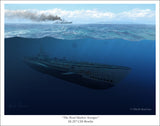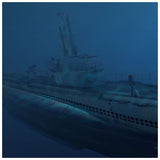I have always been fascinated by submarine warfare during WWII. The technology was sufficiently mature that a submarine, in the hands of a competent skipper and crew, was a fearsome weapon of war. Not until the advent of nuclear power would a true submarine become possible which could operate completely submerged for extended periods of time – limited only by the needs of the crew.
Like all submarines of the day, the American fleet boats of WWII could only remain submerged as long as their batteries would provide power. As battery power was nearly exhausted, the boats needed to surface in order to run the main diesel engines and recharge the batteries. This need greatly affected the strategy and tactics employed in submarine warfare.
Launched on December 7, 1942, the USS Bowfin was nicknamed “The Pearl Harbor Avenger”. The Bowfin had 9 successful patrols during the war damaging or sinking 213,580 tons of enemy shipping. Early in 1945 Bowfin was fitted with a new type of sonar which could enable the submerged submarine to detect underwater naval mines. The system was not perfect but in late May the Bowfin, along with eight other submarines, took part in one of the most daring missions of the war, Operation Barney, a mission to penetrate through the heavily mined Tsushima Strait and into the Sea of Japan.
Collectively known as “Hellcats”, the nine submarines were divided into three groups of three boats each. In the early morning darkness of June 6, 1945, Bowfin began the 16 hour dive to pass through the straight. Needless to say, every man aboard was very nervous. The new sonar would ring out to signal detection of a mine. This tone became known as “Hells Bells”. At one point, the crew could hear a cable from one of the mines scraping along the side of Bowfin. The fear that it would snag and drag the mine into the submarine was extreme however the sub soon cleared the mine.
This print depicts USS Bowfin on June 6, 1945 during her 16 hour dive through the minefields of the Tsushima Straight. Bowfin survives today and is on display in Pearl Harbor.
Like all submarines of the day, the American fleet boats of WWII could only remain submerged as long as their batteries would provide power. As battery power was nearly exhausted, the boats needed to surface in order to run the main diesel engines and recharge the batteries. This need greatly affected the strategy and tactics employed in submarine warfare.
Launched on December 7, 1942, the USS Bowfin was nicknamed “The Pearl Harbor Avenger”. The Bowfin had 9 successful patrols during the war damaging or sinking 213,580 tons of enemy shipping. Early in 1945 Bowfin was fitted with a new type of sonar which could enable the submerged submarine to detect underwater naval mines. The system was not perfect but in late May the Bowfin, along with eight other submarines, took part in one of the most daring missions of the war, Operation Barney, a mission to penetrate through the heavily mined Tsushima Strait and into the Sea of Japan.
Collectively known as “Hellcats”, the nine submarines were divided into three groups of three boats each. In the early morning darkness of June 6, 1945, Bowfin began the 16 hour dive to pass through the straight. Needless to say, every man aboard was very nervous. The new sonar would ring out to signal detection of a mine. This tone became known as “Hells Bells”. At one point, the crew could hear a cable from one of the mines scraping along the side of Bowfin. The fear that it would snag and drag the mine into the submarine was extreme however the sub soon cleared the mine.
This print depicts USS Bowfin on June 6, 1945 during her 16 hour dive through the minefields of the Tsushima Straight. Bowfin survives today and is on display in Pearl Harbor.








